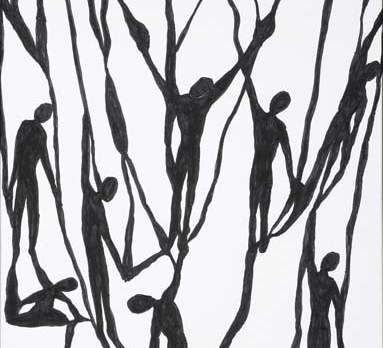Such a strange time!!!
Image: “The Climbers” by Patricia Stamm
Most people are experiencing some symptoms now not only from the Pandemic, but also from all the other chaos in the world, the latests being climate change and the unending war in Ukraine. Even healthy people are having some reactive symptoms ie. normal, mild reactions to a dangerous world, while others, are suffering from sever disorders. Symptoms may including, but not limited to any of the following: anxious and/or depressed feelings, disorientation (missing appointments, “What day is this?”), what I call the “GROUND HOG DAY phenomenon” (same thing everyday, one day blending into the next); periods of mild dissociation (drugged-like feelings where everything feels surreal or derealization where you yourself don’t feel real) as well as fear of loss of control (how long will this go on?); a sense of aloneness, irritability, frustration; concerns about work and money. Sound familiar?
But, while there are many similarities amongst people, everyone’s unique.
Some of you are coping better than others, depending on your baseline: (Who were you before this started?); any history of mental or physical illnesses, personality strengths and weaknesses, and whether/ how much you and your family are directly or indirectly affected by the world issues.
ASK YOURSELF, HOW EXTREME ARE YOUR SYMPTOMS?:
Examples of more serious symptoms: PTSD, Major Depressive Disorder, Panic Attacks, Agoraphobia, are addressed below. These are what are called clinical disorders which means significant enough by definition to interfere with daily functioning. (relationships and/or work). These may require psychiatric and/or psychological treatment.
Example #1:
Mary is a 70 year old high functioning clinical psychologist who lives alone in San Rafael. She is complaining of feelings of sadness, some hopelessness, irritability, aloneness; but continues to contact friends and sees her patients on Zoom. She is having a normal reaction to a toxic situation.
She can use the recommended strategies listed below, but she seems to be doing well enough with support from family, friends, and perhaps calls from her San Rafael Village group.
She has mild symptoms but does not exhibit serious symptoms of major depressive disorder: insomnia, suicidal thoughts or feelings, low self esteem, increased or decreased appetite, low sex drive, too much or too little sleeping, inability to have fun, low energy.
Example #2:
Bob, by contrast, a 45 year old Kaiser ICU nurse, is very depressed and anxious (unable to sleep, avoiding calls from friends, has repeated nightmares, flashbacks of dying patients, rage outbursts at his wife).
Mary can function and use the coping mechanisms I will list; whereas Bob has a major clinical disorder (post traumatic stress disorder) and will probably benefit from a psychiatrist and either cognitive behavioral therapy or mind/ body therapy.
GENERAL COPING STRATEGIES:
Do’s and Don’t’s
- Physical:
- Healthy Food
- Regular Exercise (especially walks in nature on sunny days)
- Adequate Sleep (8 hours)
- Psychological and Spiritual
- LOVE: Keeping in contact with loved ones, even long lost relatives.
- Pictures of family members displayed and readily accessible, pets, children, random acts of kindness: smiling at strangers (hard to feel bad and smile at the same time.)
- SMILING releases the happy neurotransmitters: endorphins, oxytocin, GABA, and makes everyone feel good.
- SERVICE; volunteer work
- HOPEFUL thoughts: Remember we got through AIDS; we’ll get through this; “this too shall pass”/ nothing ever stays the same.
Think of “PROCESS, not FINISHED PRODUCT” - PATIENCE!!! (“MARATHON, not a SPRINT”)
- HUMOR (laughing, joking, watching comedies, listening to upbeat as well as moving music)
- MUSIC: Singing/playing an instrument
- SPIRITUAL PRACTICES / RITUALS and ALTERS of all kinds/ meditation/ prayer/being in nature
- MEANING in LIFE: good time to think of priorities/ accomplishments
- CREATIVITY of all kinds, from knitting, crayoning in coloring books, doodling, writing poems, composing songs.
- GRATITUTE LIST
- REAL PERSON CONTACT while taking precautions
- MEANINGFUL WORK
- LIMIT NEWS: produces stimulants in our brain like Dopamine and Norepinephrine and can be addictive and add to distress
- PROACTIVE: Do something to feel you have some ACTIVE CONTROL over a small part of your life: join a volunteer organization, sign a petition, donate to a charity; as opposed to sitting /lying around as a PASSIVE VICTIM which increases a sense of no control and leads to anxiety and depression
- DISTRACTIONS of all healthy kinds. Key is: Moderation! Moderation! Moderation! Reading, (audio books if can’t read), movies (uplifting is preferable), creative hobbies, cooking, classes on zoom, organizing things
- Avoid obsessive-compulsive amounts of activities (too many hours leads to exhaustion)
- Avoid ADDICTIONS (heavy drinking, drugs, over exercising,)
- ROUTINES: keep a regular schedule
